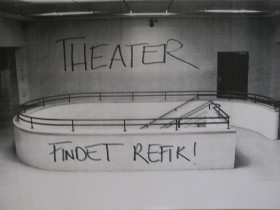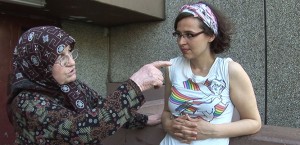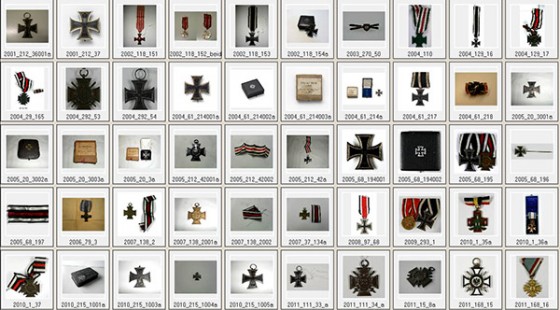
A scene from the theater play, “Findet Refik!” © Lernkultur – Institut für Bildungsforschung und Evaluation, photo: Katharina Obens
The recently approved introduction of upper secondary level teaching at the Refik-Veseli-School was a first for Kreuzberg 36, an inner-city district of Berlin, which is very popular. Now, local kids from the neighborhood called “Wrangelkiez” need no longer travel to other districts to study for the “Abitur,” Germany’s high school diploma. This is a major step towards assuring non-segregated educational opportunities in Kreuzberg
The 8th Integrated High School in the downtown district of Kreuzberg-Berlin sealed its partnership with the Jewish Museum Berlin in June 2012. Prior to that, all the staff and pupils had voted on a new name for their school and decided to call it the Refik-Veseli-School. For during a study trip to Israel, pupils had visited the Yad Vashem Museum and learned about the history of Refik Veseli—a man acknowledged being Righteous Among the Nations.
Refik Veseli was a 17-year-old apprentice in a photo studio in Tirana, Albania, when he first met the Jewish photographer Mosche Mandil, who had fled Yugoslavia to escape the National Socialists. But in 1943 the Germans invaded Albania too, and things became much more dangerous for Jews. The Veseli family owned a house in Kruje and decided to hide Mosche Mandil and his family there. It turned out to be a three-year commitment. → continue reading

Canan Turan with her grandmother
© Adriana Uribe
In our series of events “New German Stories” we present different perspectives on the immigration country Germany. That immigrants from Turkey, Vietnam, Poland, India and Cameroon and their descendants have stories to tell is nothing new—the novel twist is, that they present them here as German stories. On Tuesday, 8 July, director Canan Turan will be a guest of the Academy of the Jewish Museum. In her film KIYMET, she tells the story of her grandmother, who migrated to Berlin from Turkey in the early 70s. We asked Canan three questions about her project:
How did the idea to make a film about your grandmother Kıymet come about? → continue reading
The Jewish Museum is located in the well-known Berlin neighborhood of Kreuzberg, which is also home to a 66-meter high hill that gave the district its name in 1920: Kreuz meaning ‘cross’ and Berg ‘mount’ or ‘hill’. A monument designed by Friedrich Schinkel had been erected there about 100 years prior in memory of the war of liberation from Napoleon. On top it has always been bedecked with an Iron Cross. Prussian King Friedrich Wilhelm III first endowed the building of the monument 200 years ago, on 10 March 1813, the birthday of his late Queen Luise. A drawing of Schinkel’s design for the Iron Cross has been passed down to the Kupferstichkabinett’s collection (Museum of Prints and Drawings). In 1870 and 1914 respectively, Emperors Wilhelm I and II made subsequent endowments of the Iron Cross for particular service by German soldiers.
Numerous Iron Crosses can be found in the Jewish Museum’s collection, in many cases together with the respective certificates.

Iron Crosses in Kreuzberg – view of the object data bank of the Jewish Museum
© Jewish Museum Berlin
They nearly all date from the time of the First World War, in which around 100,000 Jewish soldiers participated on the German side. Among them were Julius Fliess (1876-1955) and Max Haller (1892-1960), whose medals are now in the Jewish Museum’s possession. → continue reading


